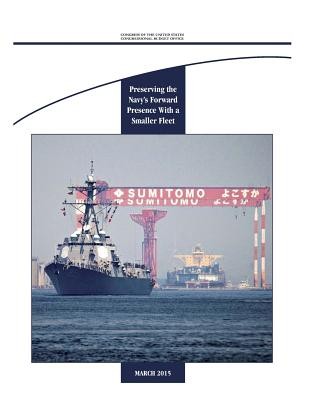
- We will send in 10–14 business days.
- Author: Congressional Budget Office
- Publisher: CreateSpace Independent Publishing Platform
- Year: 2015
- Pages: 32
- ISBN-10: 1511570210
- ISBN-13: 9781511570213
- Format: 21.6 x 28 x 0.2 cm, softcover
- Language: English
- SAVE -10% with code: EXTRA
Preserving the Navy's Forward Presence With a Smaller Fleet (e-book) (used book) | bookbook.eu
Reviews
Description
In support of its mission to deter conflict or fight in wars if necessary, the Navy considers it a core responsibility to maintain a forward presence-to keep some of its fleet far from U.S. shores at all times in areas that are important to national interests. Toward that end, at any given time, about one-third of the fleet is deployed overseas. The rest of the Navy's ships are in or near their home ports in the United States for maintenance, training, or sustainment (a period in which a ship is in port but ready to deploy quickly). Most of the ships that contribute to the Navy's current forward presence of about 100 ships sail from ports in the United States; 31 others are now stationed permanently in foreign countries or at overseas U.S. mili-tary bases. In the future, the Navy expects to boost the proportion of ships that it bases abroad. The Congressional Budget Office estimates that, for the next 30 years, the Navy's 2015 shipbuilding plan (which aims to increase the fleet from 281 ships in 2014 to 306 ships by 2022) would cost about $21 billion annu-ally, on average, in constant 2014 dollars.1 The Navy's estimates set the figure somewhat lower-at about $19 billion per year.2 Both estimates are greater than the annual average of almost $16 billion that the Navy has spent for the past three decades, which suggests that the Navy may have difficulty affording its plans. The Chief of Naval Operations' emphasis on forward operations indicates that the Navy has committed to maintaining the largest possible forward presence under any given budget plan.
- Author: Congressional Budget Office
- Publisher: CreateSpace Independent Publishing Platform
- Year: 2015
- Pages: 32
- ISBN-10: 1511570210
- ISBN-13: 9781511570213
- Format: 21.6 x 28 x 0.2 cm, softcover
- Language: English English
In support of its mission to deter conflict or fight in wars if necessary, the Navy considers it a core responsibility to maintain a forward presence-to keep some of its fleet far from U.S. shores at all times in areas that are important to national interests. Toward that end, at any given time, about one-third of the fleet is deployed overseas. The rest of the Navy's ships are in or near their home ports in the United States for maintenance, training, or sustainment (a period in which a ship is in port but ready to deploy quickly). Most of the ships that contribute to the Navy's current forward presence of about 100 ships sail from ports in the United States; 31 others are now stationed permanently in foreign countries or at overseas U.S. mili-tary bases. In the future, the Navy expects to boost the proportion of ships that it bases abroad. The Congressional Budget Office estimates that, for the next 30 years, the Navy's 2015 shipbuilding plan (which aims to increase the fleet from 281 ships in 2014 to 306 ships by 2022) would cost about $21 billion annu-ally, on average, in constant 2014 dollars.1 The Navy's estimates set the figure somewhat lower-at about $19 billion per year.2 Both estimates are greater than the annual average of almost $16 billion that the Navy has spent for the past three decades, which suggests that the Navy may have difficulty affording its plans. The Chief of Naval Operations' emphasis on forward operations indicates that the Navy has committed to maintaining the largest possible forward presence under any given budget plan.


Reviews